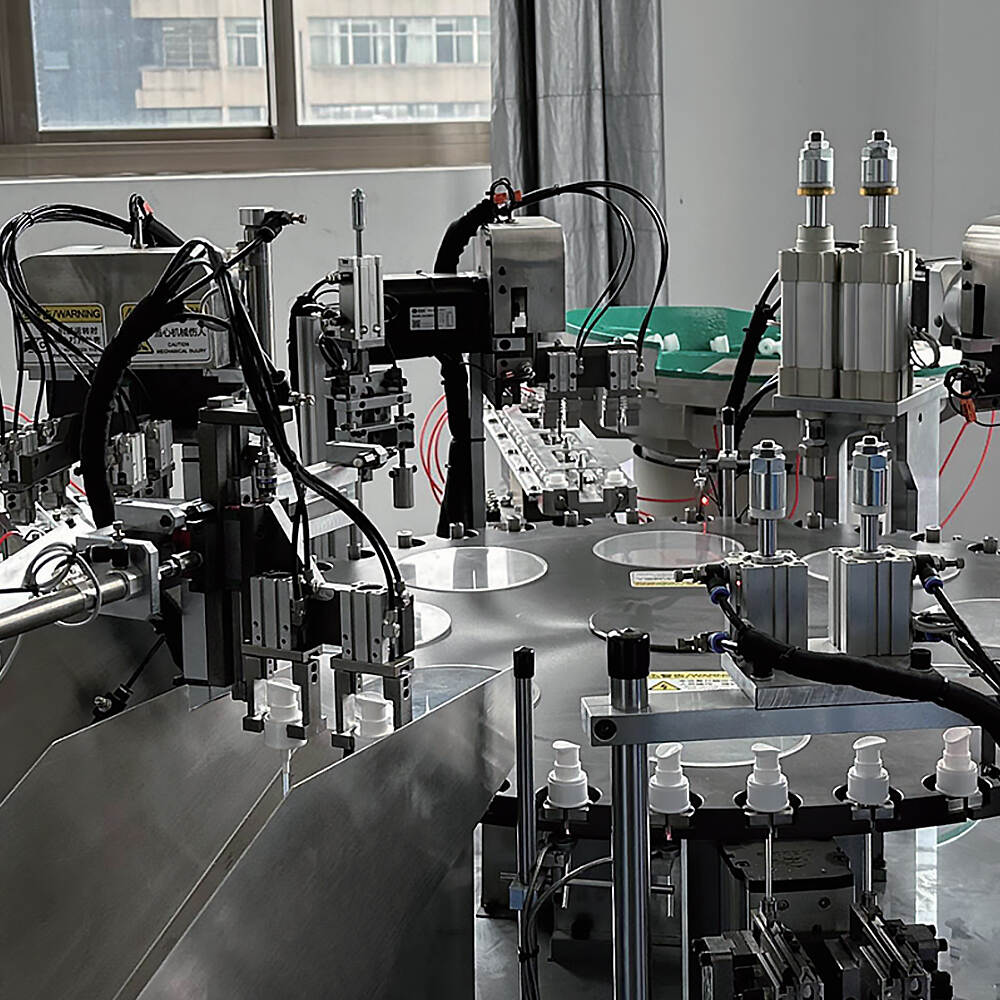Email format error
Email cannot be empty
Email already exists
6-20 characters(letters plus numbers only)
The password is inconsistent
Email format error
Email cannot be empty
Email does not exist
6-20 characters(letters plus numbers only)
The password is inconsistent


The Wonders of Pump Assembly Machines: Revolutionizing Manufacturing Efficiency
In today’s fast-paced industrial world, precision and efficiency are the cornerstones of manufacturing success. One area where these qualities are especially crucial is in the production of pumps. Whether it’s for the oil and gas industry, water treatment plants, or even household appliances, pumps play a vital role in ensuring smooth operations. This is where the pump assembly machine comes in, revolutionizing the way pumps are assembled and ultimately enhancing the efficiency of the entire production process.
In this blog, we’ll explore how the pump assembly machine works, its various benefits, and why it's becoming indispensable in modern manufacturing. So, let’s dive into the world of pump assembly and understand why these machines are making waves in the industrial sector.
What is a Pump Assembly Machine?
At its core, a pump assembly machine is an automated or semi-automated piece of equipment designed to help assemble various components of a pump. A pump typically consists of several parts like impellers, shafts, casings, bearings, seals, and motors. These components need to be carefully put together in a specific sequence to ensure that the pump operates efficiently and reliably.
While manual assembly may work for smaller operations or low-volume production, the complexity of modern pumps and the demand for high precision makes automation a necessity. The pump assembly machine streamlines this process, offering consistent and fast assembly that would be nearly impossible for human workers to match in terms of speed and accuracy.
How Does a Pump Assembly Machine Work?
A typical pump assembly machine works by automating the processes of assembling, inserting, testing, and even packaging pump components. The machine is usually equipped with various robotic arms, conveyor systems, sensors, and automated testing equipment. Let’s break down how the assembly process generally works.
Component Loading: The first step in the process involves loading the individual parts into the machine. These parts could be fed automatically via a conveyor belt or manually placed by an operator, depending on the specific system design.
Alignment and Positioning: Once the components are loaded, the assembly machine uses advanced alignment tools, such as robotic arms or mechanical guides, to position the parts precisely. This is a critical step because even the smallest misalignment can lead to pump inefficiencies or failure.
Assembly: With everything in place, the assembly process begins. The machine may use mechanical presses, screws, or welding tools to join parts together. In some cases, automated tools insert seals or bearings into specific locations to ensure a proper fit.
Testing and Quality Control: After the pump has been assembled, the machine often conducts several automated tests to check the functionality of the pump. This can include pressure testing, leakage tests, and performance checks. The sensors on the machine will verify that all parts are functioning as expected before moving to the final stages.
Packaging: Once the pump passes all tests, the assembly machine may also be responsible for the packaging process. Pumps may be placed in protective cases, labeled, and prepared for shipping, ensuring that the entire process is seamless.

Benefits of Using a Pump Assembly Machine
The introduction of pump assembly machines into manufacturing processes has brought about a wave of benefits. Let’s take a closer look at some of the most significant advantages.
1. Increased Production Speed
One of the most immediate benefits of using a pump assembly machine is the increased speed of production. Automated machines can assemble pumps much faster than human workers, reducing the overall time spent on production. This means that manufacturers can meet high demand and increase output without sacrificing quality.
2. Improved Precision and Quality Control
Precision is essential when it comes to assembling pumps. Even the smallest mistake can lead to malfunctions or inefficiencies. Pump assembly machines can assemble components with incredible accuracy, thanks to the use of robotic arms, sensors, and advanced positioning systems. Additionally, the testing mechanisms integrated into these machines ensure that each pump meets the required standards of performance.
3. Cost Efficiency
Though the initial investment in an automated assembly machine can be significant, it often results in long-term cost savings. These machines reduce the need for manual labor, minimize human error, and lower the cost of rework or repairs due to faulty pumps. Moreover, because the assembly process is faster, manufacturers can produce more units within a shorter time frame, further boosting profitability.
4. Consistency and Reliability
Manufacturers need consistency in their production lines, and that’s exactly what a pump assembly machine offers. With automation, there’s no variability in performance from one worker to another. Every pump is assembled in exactly the same way, leading to uniformity in product quality. This reliability is particularly important for industries that rely on pumps to maintain critical operations, such as the oil and gas industry or water treatment plants.
5. Enhanced Safety
Assembly lines, especially those dealing with complex or heavy components, can be dangerous environments for human workers. By automating the pump assembly process, manufacturers can reduce the risk of workplace accidents and injuries. Machines can handle heavy lifting, intricate tasks, and hazardous operations, all while keeping workers safe.
6. Flexibility and Scalability
Another remarkable feature of pump assembly machines is their flexibility. Manufacturers can easily reprogram the machines to assemble different types of pumps or adjust for varying production requirements. Whether they need to scale up production for a large order or change designs to accommodate new pump models, these machines can adapt without significant downtime.
Industries Benefiting from Pump Assembly Machines
While pump assembly machines are valuable in virtually any industry that uses pumps, certain sectors benefit more from the automation of this process. Let’s explore a few industries that are seeing significant improvements due to these machines.
1. Oil and Gas Industry
In the oil and gas sector, pumps are critical for transporting liquids, gas, and oil across pipelines. These pumps need to be reliable and durable to withstand extreme conditions. The use of automated pump assembly machines ensures that these pumps are built to the highest standards and are able to operate under demanding conditions. Speed, precision, and durability are crucial here, and automated assembly delivers on all fronts.
2. Water Treatment Plants
Water treatment plants use pumps to move water through various stages of purification and filtration. The accuracy of pump assembly is essential for ensuring that water is treated efficiently and safely. Pump assembly machines help streamline this process, resulting in fewer breakdowns and less maintenance work over time.
3. HVAC Systems
Pumps used in HVAC (heating, ventilation, and air conditioning) systems need to be compact, efficient, and highly reliable. For these systems to function correctly, pumps must maintain precise flow rates and pressure levels. Automated assembly lines ensure that these pumps are put together with the exact specifications required, improving both performance and energy efficiency.
4. Agricultural Industry
In agriculture, pumps are used for irrigation systems, pesticide spraying, and livestock water systems. These pumps must be assembled quickly and with precision to avoid delays in agricultural operations. By using pump assembly machines, manufacturers can produce large quantities of pumps that meet the required standards for agricultural use, helping to keep food production on schedule.
Future of Pump Assembly Machines
The future of pump assembly machines looks incredibly promising. With advancements in artificial intelligence (AI), machine learning, and robotics, these machines will continue to evolve, becoming even smarter and more efficient. For example, AI-driven predictive maintenance systems will help anticipate potential issues before they occur, further reducing downtime and improving the longevity of the machines.
Additionally, as demand for eco-friendly and energy-efficient pumps increases, pump assembly machines will likely integrate new technologies to produce pumps that meet these rising environmental standards. We might see automation play an even larger role in industries focused on sustainability, from renewable energy to eco-conscious manufacturing.
Conclusion
The pump assembly machine is a marvel of modern engineering, transforming how pumps are assembled across various industries. By offering increased speed, precision, cost efficiency, and flexibility, these machines have become indispensable to manufacturing plants worldwide. As technology continues to evolve, the capabilities of these machines will only improve, making them even more vital to industries that rely on pumps for critical operations.
Whether you're a manufacturer looking to improve your production processes or simply an enthusiast curious about automation, one thing is clear: pump assembly machines are here to stay, shaping the future of industrial manufacturing in ways we are only beginning to fully appreciate.

